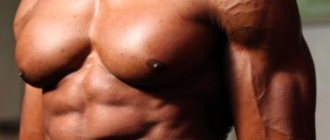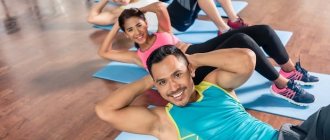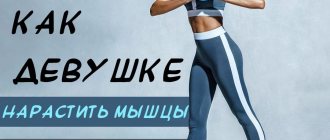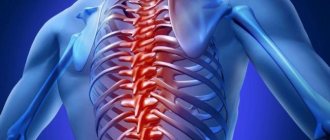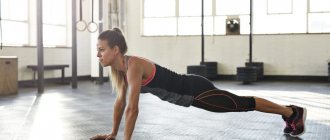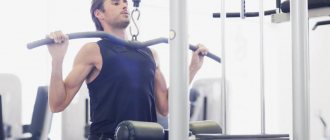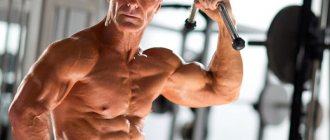The core is a large group of muscles that stabilize the spine. The main ones include the abdominal muscles, pelvic floor, and buttocks. If they are trained, then a person can notice correct posture, an easy gait, and a toned stomach. And this is only the minimum that is visible to the naked eye. Changes also occur inside the body.
However, squatting or ab training is not enough to develop the core stabilizers. Core muscle exercises are performed in a comprehensive manner to engage as many of them as possible.
What muscles make up the core and where are they located?
The core muscles are located in the middle part of the human body, in the vertebral and hip regions. Despite the fact that part of the muscle group is located on the surface (for example, the abs), the core muscles are classified as a deep type.
Core muscle location
Fitness trainers recommend that every athlete, regardless of his age and physical fitness, strengthen his core, since this muscle group is officially recognized as the center of muscular activity of the body.
On the stomach
The core muscles located in the abdominal area include:
- The rectus muscles are located in the medial region of the peritoneum . It is the condition of this part of the muscles that directly affects the presence or absence of “packs” on the stomach of a particular person;
- The transverse muscle is a muscle bundle located transversely on the sides of the rectus muscles.
On the back
The core muscles located on the back include:
- back extensors (these muscles are leading when an athlete performs various types of deadlifts - deadlifts, deadlifts, and so on);
- coracobrachialis muscle (is a flat muscle located under the head of the biceps brachii muscle);
- infraspinatus muscles (triangular, flat muscle located in the area of the deepening of the scapula).
On the buttocks
The muscles of the feed, located in the area of the lower extremities and buttocks, include:
- small and medium muscles of the buttocks (muscles belonging to the deep ones, which are located under the gluteus maximus muscle);
- adductor muscles (this group is made up of 3 types of muscles - long, short and large, which are located on the inner surface of the thigh);
- muscles of the back of the thigh (this group is formed by the biceps femoris, semitendinosus and semimembranosus muscles).
Consequences of muscle weakness
Due to weakness and general underdevelopment of the muscular corset, it can:
- posture worsens. Due to the inability of the core muscles to take on part of the load, the body weight is distributed exclusively across the spine. Under excessive load, the spinal column bends, the person begins to stoop, the shoulders can shift to different levels of height;
- loss of ability to maintain balance;
- general flexibility of the body decreases;
- deterioration of the health of the circulatory, excretory, digestive systems, as well as reproductive organs (core muscles are of particular importance for women);
- change in a negative direction the appearance of a particular person, in particular the abs and buttocks (the body becomes more flabby, muscles weaken, skin elasticity is lost, cellulite may appear);
- there is a displacement of one or more internal organs from their natural place;
- the indicator of strength and endurance decreases (this factor is especially important for athletes who care not just about physical indicators, but also about the presence of “explosive” strength necessary to make jumps, strikes or perform plyometric exercises);
- the health of the spinal column, as well as joints and tendons, deteriorates (this can lead to the premature development of serious diseases, for example, osteoporosis, osteochondrosis, and so on).
conclusions
Given the potential benefits of coactivation for the prevention and treatment of joint injuries, it is advisable to include stabilization training in rehabilitation programs. In addition, in unstable support exercises, lifting significant weights is usually excluded, but at the same time, a high level of muscle activity and coordination is observed. However, regular use of stabilization resistance training may result in decreased force production due to coactivation. For example, maximum intensity in a barbell squat may be below the recommended threshold level for stable support strength development—85% of 1RM.
The benefits of core training
The core muscles are located in 3 areas of the body, which means strengthening these areas will have a wide range of positive aspects:
- strong muscles are able to maintain stability of the spinal column, as well as the pelvic bone, minimizing the risk of injury;
- the core muscles, being in good shape, will allow you to increase your endurance and strength in the shortest possible time (on average, people without good physical training will be able to significantly increase them in 5-8 weeks of regular training);
- a strong muscle corset, helping to properly distribute the load on the back and shoulder girdle, will help maintain posture and also significantly reduce the risk of developing spinal diseases;
- training the core muscles, regardless of its location, will eliminate existing muscle tension and prevent the occurrence of new ones.
How to assess core muscle development? Home test for beginners
If you have been actively involved in sports for a long time and monitor the condition of your body, this does not mean that your core is in optimal condition. A special test for core muscle strength, including a functional assessment of movements, will help measure the degree of its development. A system of seven different exercises, developed by American specialists G. Cook and L. Burton, will allow you to assess your basic athletic level and subsequently correctly create a set of exercises for developing the core muscles that you can do.
How to test muscle strength
Testing your core muscles should include several steps:
- Testing the ability to maintain trunk stability. To do this, the athlete needs to lie on the floor, stomach down, and place a long gymnastic stick or a regular PVC tube on his back. The upper and lower limbs must be placed in the starting position, which is recommended to be taken before performing push-ups. After taking a deep breath, as you exhale, you should bend your arms and lower yourself as low as possible to the floor, while making sure that the body remains motionless (no new deflections are formed). You can check how successful the exercise can be considered by the position of the stick (if the exercise is successfully completed, it should maintain its original position and lie motionless on the athlete’s back).
- Checking the ability of the body to be in a static position. To do this, you need to alternately take the position to perform the classic and side planks (alternately, the right and left sides should be located closer to the floor). The test can be considered completed if the athlete managed to stand in a straight plank on his hands and forearms for 90 seconds, and in a side plank for at least 60 seconds for each hand.
- Checking the dynamic strength of the body . This test involves the need to lift the athlete’s legs from a hanging position on the horizontal bar. The result will be considered satisfactory if the person managed to raise his knees to the chest area at least 5 times. Ideally, your legs should be raised straight, your feet touching the bar (at least 5-7 times for women and men, respectively).
Deadlift
To evaluate the strength and stability of your back and posterior core muscles, you should perform a classic deadlift in the correct position. The optimal weight for the exercise can be determined from the table below.
Men:
| Weight | Physical level Minimum training | Physical level training Medium | Physical level Advanced training |
| 56 | 47,5 | 100 | 145 |
| 60 | 50 | 110 | 155 |
| 67 | 57,5 | 122,5 | 172,5 |
| 75 | 62,5 | 135 | 185 |
| 82 | 67,5 | 142,5 | 200 |
| 90 | 70 | 152,5 | 207,5 |
| 100 | 75 | 160 | 217,5 |
| 110 | 77,5 | 165 | 222,5 |
| 125 | 80 | 170 | 227,5 |
| 145 | 82,5 | 172,5 | 230 |
| 145+ | 85 | 177,5 | 232,5 |
Women:
| Weight | Physical level Minimum training | Physical level training Medium | Physical level Advanced training |
| 48 | 27,5 | 60 | 85 |
| 52 | 30 | 62,5 | 90 |
| 56 | 32,5 | 67,5 | 95 |
| 60 | 35 | 72,5 | 100 |
| 67 | 37,5 | 80 | 110 |
| 75 | 40 | 85 | 117,5 |
| 82 | 42,5 | 92,5 | 125 |
| 90 | 45 | 97,5 | 130 |
| 90+ | 50 | 105 | 137,5 |
General training recommendations for girls and women
The core muscles are located in three large areas of the body, which means it is recommended to train them in strict accordance with the basic rules formulated by fitness trainers for girls and women playing sports.
These are the following rules:
- Before the main part of the training, it is necessary to perform a warm-up set , the duration of which should be no more than 5-7 minutes. If an athlete has no contraindications, she should use cardio exercises as a warm-up. They will not only prepare the body for further sports, but will also increase the speed of blood flow, due to which the cardiovascular system will adequately supply the body with oxygen, increasing the athlete’s endurance during exercise;
- after the main part of the training, it is necessary to do a cool-down (it will help restore the heart rate and adjust the frequency and depth of breathing);
- during sports, it is recommended to maintain a drinking regime (otherwise, dehydration may occur, which sometimes provokes fainting or sudden jumps in blood pressure);
- The time for playing sports must be selected taking into account the characteristics of the body - biological rhythms (the time of exercise does not have any effect on the effectiveness of the training).
Prevention of limb injuries
Impaired neuromuscular control of the core muscles and/or weakness predisposes a person not only to injuries to the lower back, but also to the extremities (37, 55, 57, 68, 79, 80, 86). These connections support the need for core training to prevent injury. The rehabilitation literature reports the successful use of balance training to reduce the incidence of ankle ligament injuries in volleyball players (101), which is likely due to improved inversion control after wobbleboard training (102).
Proprioception (97) and functional balance (39) of the knee have also been reported to improve in older adults as a result of Tai Chi. The use of destabilizing devices in training reduced the incidence of LBP and increased the “sensory efficiency” of the soft tissues stabilizing the knee and ankle joints (22, 25, 100). Combining resistance training and instability can be an effective means of increasing strength and improving balance to prevent sports injuries and for people who do not want to use significant loads or weights.
Exercises at home
The core muscles are located in the back, lower extremities and abs, which means that to properly strengthen them, it is necessary to perform varied loads within one workout.
Planks
In strengthening the core muscles, one of the most effective exercises for girls are planks.
You can do them in several ways:
| Exercise | Method of execution |
| Classic plank |
|
| Side plank on the floor |
|
If a girl does not have good physical fitness or resumes training after a long break, the time spent in the plank can be halved (if there are relative contraindications, you can stand in the plank for no more than 15-20 seconds).
Bridges
To strengthen the core muscles located in the lower body, fitness trainers recommend performing the “Bridge” exercise.
It also has several variations:
| Exercise | Method of execution |
| Classic bridge |
|
| Complicated bridge |
|
Muller complex
The Müller complex, which can also be practiced to strengthen the core muscles, includes 10 simple exercises:
- Alternately raise your legs forward (to maximum height).
- Alternate leg raises to the sides (to maximum height).
- Alternately raise your legs back (to maximum height).
- Raising your heels in opposite directions. When performing this exercise while standing, your feet must be placed as far apart as possible.
- Squats. When performing this exercise, it is recommended to slowly raise your arms in front of you at chest level (the hands should be contracted), then do a deep squat, and then inhale to return to the starting position.
- Alternately moving the straight legs back (without lifting the feet from the floor). The exercise is performed while standing, with your feet parallel and at a minimum distance from each other.
- Tilt the body forward. The body should remain straight while performing this exercise.
- Tilt the body back. The body should remain straight while performing this exercise.
- Torso rotation. When performing the exercise, the feet must be separated to the maximum distance from each other, while turning them inward.
- Bent leg raises from a standing position. When performing the exercise, your feet should be positioned shoulder-width apart. As you exhale, the knee should be raised to the chest area, and while inhaling, lowered to its original position.
The term "CORE"
Without disputing the marketing component of introducing new terms, we will focus on the advisability of identifying core as a separate system. Using the extended definition proposed by Behmetal does not provide insight into the specific region of exposure. If this is not of fundamental importance when performing traditional exercises, since stabilizing muscle tension develops “by default,” then for successful rehabilitation it is important to know which region the attention is focused on. For example, the skill of stabilizing the belt of the upper limb is, first of all, learning the “scapulohumeral rhythm”, while the initial standing position is not desirable at the first stages of physical rehabilitation. Is it necessary to create systems like core, which will then have to be divided into subsystems to eliminate contradictions in research results? In our opinion, the introduction of this term (system) is unjustified either from a theoretical or practical point of view, which does not exclude its use to popularize a healthy lifestyle.
Exercises in the gym
The core muscles can be strengthened both at home and in the gym.
To work out the area of the muscles that is located in the upper body, you can use:
- various variations of hyperextension exercises (classical lifts, sit-ups with fixation at the top point, sit-ups while holding a metal plate, and so on);
- exercises on the “Butterfly” simulator;
- traction of the upper block to the chest or abdomen (with parallel reduction of the shoulder blades).
To strengthen the core muscles located in the lower part of the body, the following are suitable:
- exercise machine for bringing legs together from a sitting position;
- exercise machine for leg extensions while lying on your stomach.
To work out the abdominal muscles, it is recommended to include in your training program:
- hanging body raises;
- lifting the body from a position lying on an inclined bench;
- twisting while holding a weight, dumbbell or metal plate.
Classes in the gym, the purpose of which is to qualitatively work out the core muscles, are convenient because as part of such training you can perform exercises both in the simulator and with weights or your own weight. The combination of various types of loads significantly increases the speed at which the athlete achieves the desired result.
Core Workout Plan
A training plan aimed at working the core muscles should be drawn up in accordance with the basic principles formulated by professional athletes and fitness trainers.
Principles:
- a sign that the exercise is being performed as efficiently as possible is the presence of burning and trembling in the muscles during the last repetition of the final approach;
- the duration of the interval between approaches should be no more than 60 seconds;
- it is important to strictly follow the technique of performing the exercises (otherwise the effectiveness of the training will decrease and the risk of injury to the athlete will increase);
- all core muscle groups should be worked out evenly (this is necessary to maintain the proportionality of the body);
- The training program must be changed every 3-4 weeks, since during this period the muscles adapt to the loads, which means the effectiveness of the exercises performed is significantly reduced, regardless of the regularity of the exercises.
How women can strengthen their core without increasing their waist size.
To strengthen the core muscles without increasing waist size, girls are recommended to:
- when performing exercises, focus on the lower part of the abs, as well as stabilizing the lumbar spine;
- when determining the optimal number of approaches, it is important to pay attention to general well-being, and not a specific number of repetitions (muscles should tremble and “burn”);
- the frequency of training to strengthen the core muscles should be at least 2 times a week;
- the number of repetitions for a beginner should be 8-9 per approach (after a week the number of repetitions can be increased by 2), and for a professional - at least 12;
- In addition to properly organized training, the girl must adhere to the principles of proper nutrition (you should not follow diets, since after leaving them the progress achieved will quickly be lost).
The core muscles, despite the fact that they are located in several parts of the body, require uniform development with the help of appropriate physical activity . Provided the training process is properly organized, the muscles will help improve posture, increase blood flow to the internal organs, and also reduce the risk of the occurrence and development of spinal diseases.
